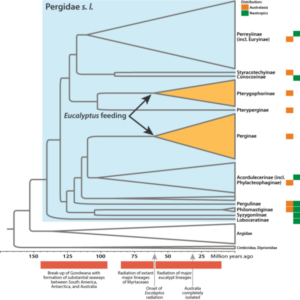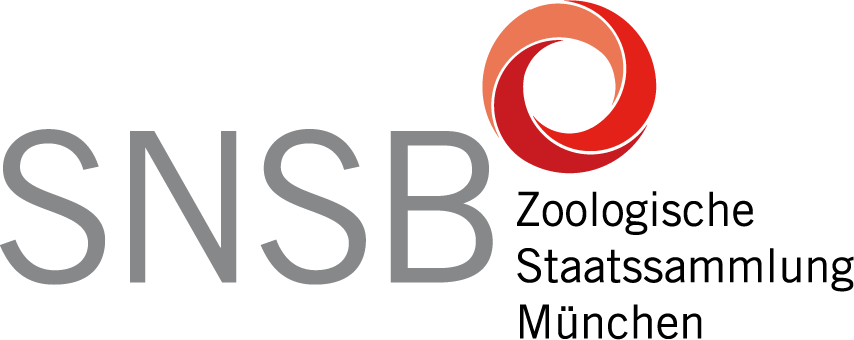Adaptive Radiation of Gondwanan Pergid Sawflies (Hymenoptera, Pergidae)
Sektion Hymenoptera
Major evolutionary transitions and diversification of the eucalypt-feeding pergid sawflies in Australia
The Pergidae are Gondwanan, with Australia and South America being the centres of diversity, and with no species in southern Africa. The majority of Australian pergid species is associated with host plants of the family Myrtaceae, which is typically Gondwanan in distribution.

Simplified phylogeny of Pergidae with host plant information in relation to major geological events.
A calibrated phylogeny of the family Pergidae indicates that the major lineages within the family evolved during the fragmentation of the Gondwanan supercontinent. The split between the Pergidae and its sister group Argidae is estimated at about 153 Myr ago. No central dichotomous division between Australian and South American pergid sawflies was observed, showing that the major lineages within this group had already evolved by the time Australia had become completely isolated from Antarctica. The molecular dating analysis strongly indicates a co-radiation of Australian pergid sawflies with their Myrtaceae hosts and suggest that the two eucalypt-feeding clades, pergines and pterygophorines, colonised their eucalypt host plants independently during the Palaeocene, at the time when their hosts appear to have started radiating.
The break-up of Gondwana and the timing of the subsequent climatic change in Australia, leading from vegetation adapted to aseasonal-wet conditions to the arid-adapted sclerophyll vegetation typical of Australia, suggest that the species-poor subfamilies occurring in rainforests represent remnants of more diverse groups that were decimated through loss of habitat or host species. Chemical detoxification vs mechanical removal of host plant toxins in Eucalyptus feeding sawfly larvae
Eucalyptus leaves are notoriously rich in essential oils, some of which are strong toxins for insects that have no specific defence against them (e.g. cineole). Nevertheless, some herbivores are eucalyptus specialists, and most of these have specialized enzymes to detoxify particular components within their usual diet. Only a few insect groups have managed to adapt to such circumstances and to diversify widely on eucalypts. Of these, the pergine sawflies are unique, even among all herbivorous insects with mandibles: the larvae have a large, soft, sponge-like extension (the scopa mandibularis) on what is usually the grinding surface of the insect mandible (pictures below).

Left: grinding surface of the mandible of larvae of the pergid subfamily Perginae. The pale area with the numerous protrusions is the soft sponge-like extension (the scopa mandibularis). Right: SEM of both mandibles. L, labrum; LM, left mandible; RM, right mandible; SM, scopa mandibularis (from Schmidt et al., 2000).
Project collaboration
G.H. Walter, School of Biological & Chemical Sciences, The University of Queensland, Brisbane, Australia.
Project support

Deutsche Forschungsgemeinschaft (DFG SCHM1281/1-1, SCHM1281/2-1, SCHM1281/3-1).
Publications
Schmidt, S., Walter, G.H. (2014) Young clades in an old family: major evolutionary transitions and diversification of the eucalypt-feeding pergid sawflies in Australia (Insecta, Hymenoptera, Pergidae). Molecular Phylogenetics and Evolution 74: 111-121. DOI:10.1016/j.ympev.2014.02.002
Schmidt, S. & Walter, G.H. (2011) Adapting to cope with eucalypt oils: Mandibular extensions in pergid sawfly larvae and potential preadaptations in its sister family Argidae (Insecta, Hymenoptera, Symphyta). Journal of Morphology 272:1314–1324. DOI: 10.1002/jmor.10985.
Schmidt, S., McKinnon, A.E., Moore, C.J. & Walter, G.H. (2010) Chemical detoxification vs mechanical removal of host plant toxins in Eucalyptus feeding sawfly larvae (Hymenoptera: Pergidae). Journal of Insect Physiology 56: 1770-1776. DOI:10.1016/j.jinsphys.2010.07.006
Schmidt, S., Walter, G.H., Grigg, J. & Moore, C.J. (2006). Sexual Communication and Host Plant Associations of Australian Pergid Sawflies (Hymenoptera, Symphyta, Pergidae). Pages 173-193 in: Blank, S., Schmidt, S. & Taeger, A. (eds), Recent Sawfly Research: Synthesis and Prospects. Goecke & Evers, Keltern, 720 pp. (PDF, 1,1MB)
Schmidt, S., G.H. Walter & C.J. Moore (2000). Host plant adaptations in myrtaceous-feeding Pergid sawflies: essential oils and the morphology and behaviour of Pergagrapta larvae (Hymenoptera: Symphyta: Pergidae). Biological Journal of the Linnean Society 70: 15-26. DOI: 10.1006/bijl.1999.0364

